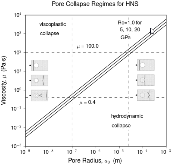|
Modeling heterogeneous energetic materials at the mesoscale
|
journal
|
February 2002 |
|
UFF, a full periodic table force field for molecular mechanics and molecular dynamics simulations
|
journal
|
December 1992 |
|
Shock Waves in High-Energy Materials: The Initial Chemical Events in Nitramine RDX
|
journal
|
August 2003 |
|
Dynamic Behavior of Materials
|
book
|
September 1994 |
|
Charge equilibration for molecular dynamics simulations
|
journal
|
April 1991 |
|
Direct numerical simulation of shear localization and decomposition reactions in shock-loaded HMX crystal
|
journal
|
May 2015 |
|
Initiation of Detonation by the Interaction of Shocks with Density Discontinuities
|
journal
|
January 1965 |
|
Probabilistic models for reactive behaviour in heterogeneous condensed phase media
|
journal
|
February 2012 |
|
Fast Parallel Algorithms for Short-Range Molecular Dynamics
|
journal
|
March 1995 |
|
ReaxFF Reactive Force Field for Molecular Dynamics Simulations of Hydrocarbon Oxidation
|
journal
|
February 2008 |
|
Computational prediction of probabilistic ignition threshold of pressed granular octahydro-1,3,5,7-tetranitro-1,2,3,5-tetrazocine (HMX) under shock loading
|
journal
|
September 2016 |
|
Empirical interatomic potential for silicon with improved elastic properties
|
journal
|
November 1988 |
|
QM/MM Methods for Biomolecular Systems
|
journal
|
January 2009 |
|
Charge optimized many-body potential for the system
|
journal
|
February 2007 |
|
Extended asymmetric hot region formation due to shockwave interactions following void collapse in shocked high explosive
|
journal
|
August 2016 |
|
Hot spot ignition mechanisms for explosives
|
journal
|
November 1992 |
|
Detonations at nanometer resolution using molecular dynamics
|
journal
|
April 1993 |
|
The Role of Rapidly Compressed Gas Pockets in the Initiation of Condensed Explosives
|
journal
|
September 1974 |
|
Modified embedded-atom potentials for cubic materials and impurities
|
journal
|
August 1992 |
|
A Method for Tractable Dynamical Studies of Single and Double Shock Compression
|
journal
|
June 2003 |
|
Ultrafast Chemistry under Nonequilibrium Conditions and the Shock to Deflagration Transition at the Nanoscale
|
journal
|
September 2015 |
|
Comparison of Three Methods for Selecting Values of Input Variables in the Analysis of Output from a Computer Code
|
journal
|
May 1979 |
|
A thermomechanical analysis of hot spot formation in condensed-phase, energetic materials
|
journal
|
May 1992 |
|
Probing the limits of metal plasticity with molecular dynamics simulations
|
journal
|
September 2017 |
|
Sensitization of two-dimensional detonations in nitromethane by glass microballoons
|
journal
|
April 1999 |
|
Coarse-Grain Model Simulations of Nonequilibrium Dynamics in Heterogeneous Materials
|
journal
|
June 2014 |
|
Static and Dynamic Pore‐Collapse Relations for Ductile Porous Materials
|
journal
|
April 1972 |
|
On the effect of grain size on shock sensitivity of heterogeneous high explosives
|
journal
|
April 1997 |
|
The Art and Science of an Analytic Potential
|
journal
|
January 2000 |
Ignition Mechanisms of Explosives during Mechanical Deformation
- Field, J. E.; Swallowe, G. M.; Heavens, S. N.
-
Proceedings of the Royal Society A: Mathematical, Physical and Engineering Sciences, Vol. 382, Issue 1782
https://doi.org/10.1098/rspa.1982.0099
|
journal
|
July 1982 |
|
The ReaxFF reactive force-field: development, applications and future directions
|
journal
|
March 2016 |
|
Coupled Thermal and Electromagnetic Induced Decomposition in the Molecular Explosive αHMX; A Reactive Molecular Dynamics Study
|
journal
|
January 2014 |
|
Computational aspects of many-body potentials
|
journal
|
May 2012 |
|
A constitutive model for strain rates from 10 − 4 to 10 6 s − 1
|
journal
|
February 1989 |
|
Extended Born-Oppenheimer Molecular Dynamics
|
journal
|
March 2008 |
|
Microscopic View of Structural Phase Transitions Induced by Shock Waves
|
journal
|
May 2002 |
|
Embedded-atom method: Derivation and application to impurities, surfaces, and other defects in metals
|
journal
|
June 1984 |
|
ReaxFF- l g: Correction of the ReaxFF Reactive Force Field for London Dispersion, with Applications to the Equations of State for Energetic Materials
|
journal
|
October 2011 |
|
ReaxFF: A Reactive Force Field for Hydrocarbons
|
journal
|
October 2001 |
|
Nanobubble Collapse on a Silica Surface in Water: Billion-Atom Reactive Molecular Dynamics Simulations
|
journal
|
October 2013 |
|
A physically-based Mie–Grüneisen equation of state to determine hot spot temperature distributions
|
journal
|
June 2016 |
|
Electric Detonators: EBW and EFI
|
journal
|
June 1996 |
|
Visualization and analysis of atomistic simulation data with OVITO–the Open Visualization Tool
|
journal
|
December 2009 |
|
Effects of void size, density, and arrangement on deflagration and detonation sensitivity of a reactive empirical bond order high explosive
|
journal
|
December 2010 |
|
Collapse of void arrays under stress wave loading
|
journal
|
April 2010 |
|
Shock initiation of explosives: High temperature hot spots explained
|
journal
|
August 2017 |
|
Differences between the detonation behavior of emulsion explosives sensitized with glass or with polymeric micro-balloons
|
journal
|
May 2014 |
|
Real time ultrafast spectroscopy of shock front pore collapse
|
journal
|
November 2001 |
|
Critical Conditions for Impact- and Shock-Induced Hot Spots in Solid Explosives †
|
journal
|
January 1996 |
|
A second-generation reactive empirical bond order (REBO) potential energy expression for hydrocarbons
|
journal
|
January 2002 |
|
Detonations at Nanometer Resolution Using Molecular Dynamics
|
journal
|
March 1996 |







